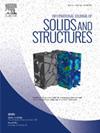面向全向隔振的高宽频带非局部超表面设计
IF 3.4
3区 工程技术
Q1 MECHANICS
International Journal of Solids and Structures
Pub Date : 2025-06-27
DOI:10.1016/j.ijsolstr.2025.113547
引用次数: 0
摘要
无源弹性超表面作为一种先进而有力的弹性波操纵新兴元件,其设计主要受限于窄带宽的限制,对实际工程应用提出了巨大的挑战。最近,非局部超表面在声学和光学中获得了突出的地位,利用远程耦合效应来诱导非平凡波操纵现象。然而,弹性波操纵的研究主要集中在解耦的局部超表面上,忽略了单元胞之间的耦合相互作用,这限制了宽带特性的展示。为了实现稳健的、整体形成的、结构简单的宽带弹性波操纵,必须全面考虑单元胞之间的远程力。本文提出了一种基于非局部机构的解析晶格模型和宽频带隔振弹性超表面设计范式。本文提出的非局部超表面利用多目标进化优化算法(NSGA-III),通过精心设计单元胞之间的连接,通过相位调制和阻抗调制实现全向宽带隔振。建立了包含耦合结构的多自由度等效模型,从理论上阐述了非局部物理效应对超表面动力响应的影响。设计了异形隔振笼,通过数值模拟和实验验证了其全向宽带弹性隔振能力。该策略为扩展现有局部元表面的操作带宽提供了一种可靠有效的方法,从而促进了宽带弹性波操作元表面的多样化应用场景。本文章由计算机程序翻译,如有差异,请以英文原文为准。
Towards design of a nonlocal metasurface with highly broadening bandwidth for omnidirectional vibration isolation
As an advanced and potent emerging component for the manipulation of elastic waves, the design of passive elastic metasurfaces is predominantly constrained by narrow bandwidth limitations, posing formidable challenges for practical engineering applications. Recently, nonlocal metasurfaces have gained prominence in acoustics and optics, leveraging long-range coupling effects to induce nontrivial wave manipulation phenomena. However, research on elastic wave manipulation has predominantly concentrated on decoupled local metasurfaces, neglecting the coupling interactions between unit cells, which restricts the demonstration of broadband characteristics. It is imperative to comprehensively consider the long-range forces between unit cells to achieve robust, integrally formed, and structurally simple broadband elastic wave manipulation. This paper proposes an analytical lattice model and a broadband vibration isolation elastic metasurface design paradigm predicated on nonlocal mechanisms. The proposed nonlocal metasurface achieves omnidirectional broadband vibration isolation through phase modulation and impedance modulation by establishing meticulously designed connections between unit cells, utilizing the multi-objective evolutionary optimization algorithm (NSGA-III). A multi-degree of freedom equivalent model containing the coupled structures is developed to theoretically elucidate the impact of nonlocal physical effects on the dynamic response of the metasurface. An irregularly shaped vibration-isolation cage was designed, and its omnidirectional broadband elastic wave isolation capability was validated through numerical simulations and experiments. This strategy provides a reliable and effective approach to extending the operational bandwidth of existing local metasurfaces, thereby facilitating broadband elastic wave manipulation metasurface for diverse application scenarios.
求助全文
通过发布文献求助,成功后即可免费获取论文全文。
去求助
来源期刊
CiteScore
6.70
自引率
8.30%
发文量
405
审稿时长
70 days
期刊介绍:
The International Journal of Solids and Structures has as its objective the publication and dissemination of original research in Mechanics of Solids and Structures as a field of Applied Science and Engineering. It fosters thus the exchange of ideas among workers in different parts of the world and also among workers who emphasize different aspects of the foundations and applications of the field.
Standing as it does at the cross-roads of Materials Science, Life Sciences, Mathematics, Physics and Engineering Design, the Mechanics of Solids and Structures is experiencing considerable growth as a result of recent technological advances. The Journal, by providing an international medium of communication, is encouraging this growth and is encompassing all aspects of the field from the more classical problems of structural analysis to mechanics of solids continually interacting with other media and including fracture, flow, wave propagation, heat transfer, thermal effects in solids, optimum design methods, model analysis, structural topology and numerical techniques. Interest extends to both inorganic and organic solids and structures.

 求助内容:
求助内容: 应助结果提醒方式:
应助结果提醒方式:


